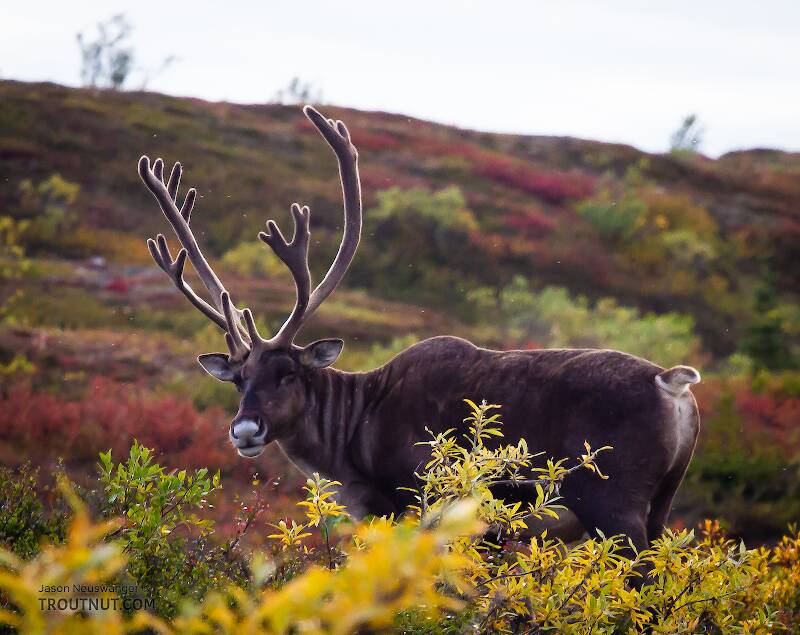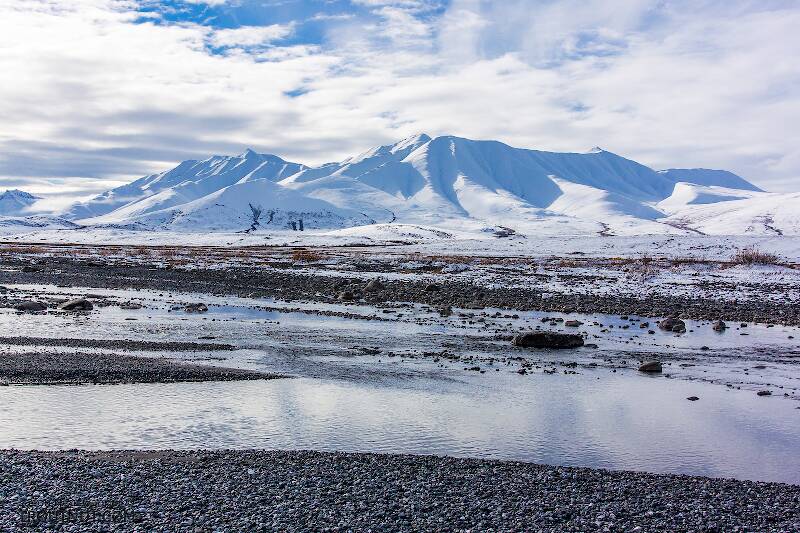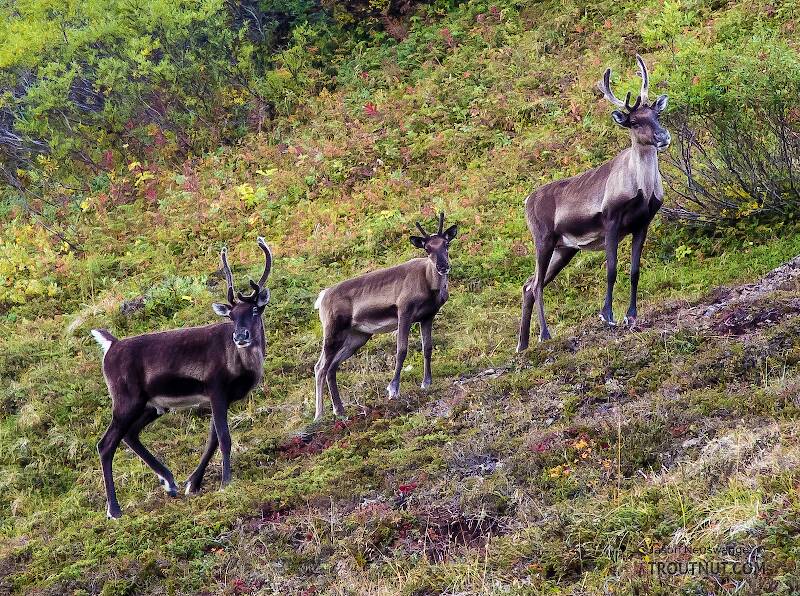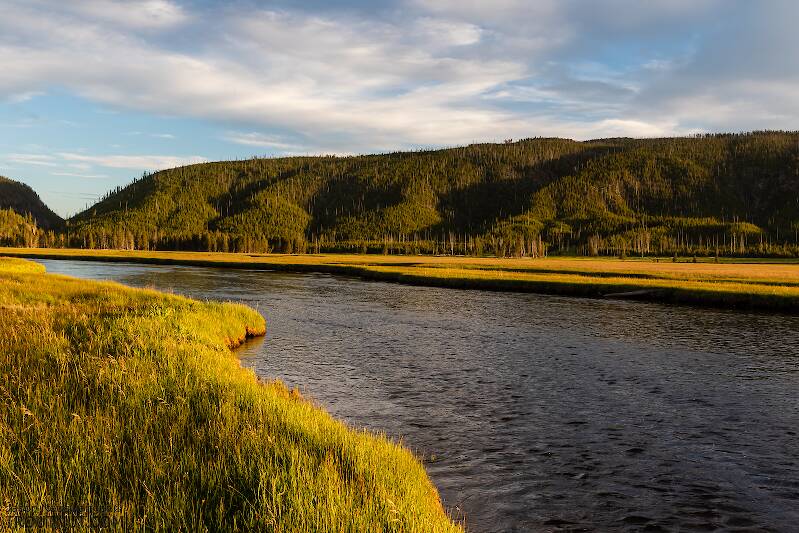See Jason's account of Day Four for photos.
Sunday, August 30, 2014 -- "a day that will live in infamy..."
We awoke to blue sky and sunshine, with temperature somewhere in the mid-30s. A quick check of the meat cache indicated no uninvited visitors during the night. Cheered by the light and the promise of coming warmth, we made time to revel in the spectacular view – the confluence of Pass Creek and Clearwater Creek with snow-capped mountains in the background. Jason and I agreed we had never camped in a more scenic place. I fired up the Jetboil unit and enjoyed hot coffee while contemplating my insignificance in this vast landscape.
During this early morning hour of leisure, Jason located and photographed a small cow/calf group of caribou on a distant ridge. We were comforted by the fact that we already had a caribou bagged and ready for transport. All we had to do was break camp and get our meat, our gear, and ourselves 650 vertical feet downhill, one-half mile across the valley floor, and 15 river miles downstream. After three arduous days followed by increasingly cold nights, I was relieved that we would not be pushing the weather envelope by spending yet another night at this altitude. We were not willing to assume the entire day would be free of precipitation, so we hastened to make a meat run to a gravel bar on Clearwater Creek below.
Jason’s meat-filled pack must have weighed nearly 100 pounds, and mine was at least 70, so we dressed lightly and still had to peel off layers as we carefully worked our way down the steep, rocky slope into the valley below. This was not particularly dangerous work, but we still needed to descend carefully and find the path of least resistance, knowing we would have to ascend and descend one more time to retrieve all our gear. During a rest stop, Jason spotted two different bull moose across Pass Creek in the valley below. Light glinting off massive antlers revealed their location against a darker background of willows and alders. After an hour of careful path-finding, making use of existing game trails wherever possible, we arrived at the gravel bar, around which two shallow channels were flowing. We waded across the smallest channel and found a small clump of willows in which to stow the meat.
As Jason arranged the last game bag in the shade of the willows, I heard splashing upstream and glanced over to see a lone gray wolf crossing the river not 100 yards away – possibly the same animal we had seen through binoculars from camp the previous morning. It was upwind and unaware of our presence, but our meat cache would be vulnerable to scavengers like this wolf for at least three hours while we traveled back uphill to retrieve our gear. We decided to frighten the animal before it realized there was food nearby. Jason waved his arms and shouted as he ran toward the wolf, who seemed unimpressed. Finally, Jason fired a shot into the ground that sent the wolf fleeing. We hoped that would buy us enough time to pack out before it returned. Most Alaskan hunters would have shot the animal on sight in this designated predator-control zone, but the opportunity to see these creatures in the wild is valued more by us than any slight reduction in the inter-specific competition for caribou.
The walk back up the steep slope, even with an empty pack, was arduous. But I was motivated by the knowledge that it would be my last strenuous climb of the trip. Jason climbed easily and waited patiently for his 59-year-old father until we finally arrived at camp. Clouds were beginning to gather, and it was already well past noon, so we began to feel a sense of urgency. We were fortunate that almost everything had finally dried out, so we crammed our packs to the limit and headed back downhill by 3:30 p.m. To our relief, the meat cache remained intact on the gravel bar, so we inflated our packrafts and prepared our gear for the float out.
We were surprised to encounter two young hunters from Anchorage who set up camp near our gravel bar as we were about to leave, so we visited with them and learned about alternate routes into this rough country. The more experienced of the two expressed some respectful concern about our rafting through a couple tricky stretches of whitewater, informing us there was a canoe wrapped around a boulder part way down. According to him, the rapids were not real dangerous, but some inconveniently placed boulders got one’s heart pounding at times. He also provided helpful advice about keeping to the right (west) approximately a mile into the trip in order to avoid a long series of beaver dams in the eastern braid of channels. We thanked him for the briefing and launched our rafts at ~4:30 p.m., thinking it would take a maximum of 5 hours to float out if we traveled at an average speed of only 3 miles/hour. If all went well, we should arrive at the bridge over the Denali Highway just before dark.
the first mile of our journey, we had to drag the rafts through a few shallow riffles, so I did not affix the body-confining “splash curtain” to my 5-pound Alpacka. As our float progressed, the river deepened and provided a continuous, moderately swift, and scenic ride through the valley. Jason was paddling a heavy-duty, 15-pound PR-49 “Packraft Alaskana” purchased from Pristine Ventures – a wilderness supply company in Fairbanks. He sat higher in his raft than me, so he led the way and picked good routes through some “boulder gardens” that Wisconsin canoeists would label Class 2 if not Class 3 rapids (all Class 1 on the Alaska whitewater rafting scale). Intense concentration and sometimes feverish paddling were required to safely navigate these reaches. With a 70-pound backpack overloading the front of my lightweight raft, large standing waves frequently splashed over the bow, soaking my raingear and forming a small pool in the bottom of the raft. Despite getting wet inside (from sweat) and out, the physical exertion kept us warm in the 50-degree air. These reasonable challenges and mild concerns were overshadowed by the beauty of the mountains around us and the feeling that we were “getting off easy” by floating, rather than carrying, this caribou and our gear out to the Denali Highway. That feeling was short-lived.
Approximately 5.2 river miles upstream of our takeout at the highway bridge, we encountered the supposedly Class 2 (Alaska scale) rapids (translation: Class 3-4 for Wisconsin canoeists) where we could see just around the next bend a canoe grotesquely wrapped around a boulder, bent 90 degrees at its longitudinal midpoint. We had been warned about this place by the hunters we met earlier. Playing it safe (we thought), we pulled to shore where we could study this stretch of whitewater before deciding whether to portage around it, line the rafts down it, or carefully run it. The problem was, we stopped a bit too late, and we stopped on the outside of the bend. We were tied off along some dense, overhanging willows at the upper end of the rapids, but it would have been impossible for Jason and very difficult for me to line our rafts back upstream against the swift current in order to cross to the other side – the inside of the bend – to line the rafts down. After bush-whacking our way a few hundred yards downstream and back through a dense tangle of riparian willows and alders, Jason decided he could make it to calmer water if he carefully maneuvered his raft as close to shore as possible. I would watch his progress; and if he made it, I would try also.
While standing in knee-deep water near shore and preparing for this uncertain event, a wayward willow branch caught my $600 eye glasses and flung them into the swift current below. I remember hollering, “Oh, NO!” followed by a couple expletives that need not be repeated. I could not imagine locating my glasses in such fast water against a cobblestone background through the turbulent, light-scattering surface. Jason (30 yards downstream of me) had not yet begun his run, so I yelled what happened over the roar of the rapids and began what I was certain would be a futile search for my glasses – all the while chastising myself for not bringing a back-up pair. I carefully worked my way downstream a few feet, and within 20 seconds was astonished to see the subtle purplish hue of my lenses that appears whenever they are wet (caused by the anti-glare coating). I removed my wet glove, reached down between those twin purple ovals, and dredged up my glasses in disbelief, grateful to find them unbroken and unscratched. One bullet dodged… more to follow.
Feeling bolstered by my recovery from a potentially sickening loss, I watched as Jason successfully ran the rapids on the course he had charted. Now it was my turn. My plan was to go hand-over-hand along the overhanging willows in order to maintain a slow, steady pace and stay close to shore – almost like lining the raft down. From my starting point, that would have worked. But as I moved downstream, current velocity increased. Soon it was difficult to keep the raft from being swept away in the strong current; and in a very brief instant my clinging to the willows brought my center of gravity far enough backward that water began pouring into the back of the raft from upstream. In a heartbeat I was dumped into two feet of fast-flowing water, my raft and pack upside down in the current as I held onto it and the shoreline willows with all my strength. Only my chest and head were above the freezing-cold water as I struggled to maintain control of the raft. My muscles were getting fatigued, and I needed some way to secure the raft to shore. Finally I was able to unbuckle the backpack waist belt, wrap it around a clump of willows, and buckle it back up – providing some temporary relief from the strain of fighting the current myself. At this point in time, I saw Jason hurrying upstream along the opposite bank, his orange paddle raised high for me to see. I barely had time to yell to him what happened when my willow-clump anchor began to fail; and we both watched with chagrin as my raft hurtled down through the rapids with my backpack and most of my belongings attached – hopefully firmly. More expletives.
Jason hurried downstream to try to intercept my raft at the next bend, shouting at me to head downstream on my side until we could meet up. I dragged myself out of the water and began the arduous journey downstream through the densely vegetated corridor. Fortunately, my bear spray and GPS unit were still attached to my life vest, but I had no way to make fire. I remember thinking, “This could be a LONG night,” as it was already after 7:00 p.m. and I had no idea how long it might take to rendezvous with Jason. I bushwhacked at least a quarter mile, at one point climbing to the top of a riparian esker to see if I could spot anything encouraging. Nothing. I continued on, worrying about Jason and wondering what we would do if the rafts had been swept so far downstream that we could not meet up again before dark. GPS revealed I was exactly 1.6 miles across the river and north of the Denali Highway as the crow flies; but crows don’t fly through scrub tundra, especially in the dark. I had a headlamp in my pocket, but the spare batteries had washed downstream. Dark humor invaded my thoughts as I entertained the notion of playing the starring role in an episode of the new reality TV show entitled, “Dude, You’re Screwed.” I still had my kayak paddle to use as a walking stick of sorts, musing that I was actually “up the creek with only a paddle.”
Just as I was beginning to think this was going to be the longest night of my life, I crested a small rise and saw my bright blue packraft on a gravel island on the inside of the next bend, tended by my son who had chased it down and secured it. What a relief! I made my way down to the bend and was able to cross the river carefully in a swift, foot-deep riffle. Jason quipped, “Well, at least you’ll have some good stories to tell.” Mostly I felt an overwhelming sense of relief at having rejoined my son and recovered most of our gear, however wet it might be. I lost only a folding knife, some fire-making material, rope, caribou jerky, trail mix, and a few minor packraft accessories in the detachable top compartment of my backpack, which was loose in the raft when it overturned. Our losses could have been far worse.
With 5.2 river miles left to go and a belief that “the worst is behind us,” we decided to place my backpack atop Jason’s in the back of his 900-pound capacity raft, allowing me to become far more maneuverable for the remainder of the trip. From my perspective, the extra 70 pounds did not visibly affect his buoyancy or maneuverability. We launched the rafts and resumed our downstream journey, actually enjoying the scenery and somewhat slower water once my paddling generated enough heat to overcome the chilling effect of wet clothing. Because my spill had cost us at least an hour, we would have to paddle vigorously to make it to the bridge before nightfall. Nobody should float this river in the dark.
We were surprised to meet at least four different parties of hunters lining their rafts or canoes upstream to hunt the area we had just left. Given the fast current and thick riparian vegetation in many places, I could only imagine how difficult it would be to tow a watercraft even one mile up this river. An apparently fit, middle-aged woman was struggling gamely to make headway as she followed her male partner upstream while towing her own 12-foot canoe full of gear. You have to want a moose or a caribou pretty badly to work so hard with no guarantee of success. Two well-equipped male hunters with a large, rowable raft had already made camp for the night when we passed their gravel bar. They were kind enough to offer us a place by their small fire; but at this point in time, daylight was more important than comfort, so we moved on quickly after telling them about our trip route and hearing them say, “Man, you guys are hard-core.”
We paddled hard once we reached that portion of the river that approximately parallels the Denali highway for the last couple miles. Dusk was approaching, and the frequent rapids were once again becoming more dangerous than advertised. My arms were aching and my energy was waning when we rounded the last bend in a Wisconsin Class 3 rapid and could see the bridge and take-out point on the left descending bank. Jason was about 30 yards ahead of me, choosing good routes around and through the boulder field. We had finally reached safe harbor, and none too soon, because it was almost too dark to read the river.
That’s when all hell broke loose. A small but fast-flowing tributary – the Little Clearwater River – entered our path on the left descending bank of the Clearwater only 20-40 yards upstream of the wide gravel landing. Downstream was another turbulent, boulder-strewn rapid that passed under the bridge and extended several hundred yards, so we did not want to miss our opportunity to paddle left and land. Still recording video with a Go-Pro camera on his head, Jason entered the confluence of the two rivers with his landing zone only a few yards away. And from 30 yards upstream, I watched in horror as his raft turned upside down!
It was at least 6 feet deep at the confluence where Jason spilled, so he did not hit his unprotected head on any rocks. I saw his head alongside the raft almost immediately, and with minor relief shouted, “Hang on son, I’ll get downstream of you!” Jason’s depth decreased to 2 feet as he drifted downstream, allowing him to dig in with both feet and hang onto the overturned raft the best he could while I shot across the surface of the confluence with adrenalin-fueled strokes. I leaped from my raft, stumbled onto the gravel bar, cursed, and sprinted downstream along the open gravel shoreline in an attempt catch Jason and his raft before they were swept further downstream. During this time, I was vaguely aware of several people onshore who were running to our aid, but I passed them and got in a position to grab the raft just before it reached the point of no return.
Up to my chest in 2 feet of water, leaning heavily upstream with my left hand firmly attached to a thick willow branch and my right hand gripping the raft rope, I dug in my heels and kept the raft from drifting any farther downstream. I was vaguely aware that Jason was doing the same thing on the riverward side of the raft, though he did not have the benefit of an onshore handhold. Together, we could hold the raft for a bit, but with the force of water pushing against overturned backpacks, there was no way we were going to pull the load upstream and out onto the gravel bar by ourselves. That’s when our gravel-bar guardians went into action. Several people entered the water and grabbed onto the collar of my life vest and presumably Jason’s as well. The combined strength of several people finally allowed us to pull the raft and all our gear up and out onto the bank. Jason recorded the entire incident on his Go-Pro camera.
For at least a full minute there was much huffing and puffing interspersed with a profusion of “Thank you’s!” from us and “Are you guys alright?” from our rescuers. We had just dodged a serious bullet. There was still some “fog of war” confusion as we tried to understand and explain what had happened while examining our gear in the semi-darkness to see what, if anything, had been lost. Unfortunately, two of the six game bags filled with caribou meat were swept downriver. Everything else, though soaked, was intact. Jason’s camera was fortuitously captured by his backpack cover. He and I were wet, cold, exhausted… and feeling very, very lucky.
When we planned this trip, there was no guarantee that any humans would be camped at the landing near the bridge. For that reason, we had chained Jason’s mountain bike to a steel guard rail so he could peddle it several miles west to pick up our vehicle at the put-in point for our hike in. But our rescuers had set up a major hunting camp with numerous RVs and a roaring campfire, which was just what we needed under the circumstances.
It was heartening to receive such generous help from strangers who were just trying to relax around their campfire after a long hard day of hunting themselves. We quickly introduced ourselves to the patriarch of the family, an Eyak native from Valdez. He and his wife were two of the people who had hauled us out of the river. After welcoming Jason to change into dry clothes in one of their trailers, they offered to drive Jason down the road to pick up our vehicle. All my clothes were wet, so I peeled off top layers next to the fire and warmed myself as I visited with the rest of the family, all of whom shall remain anonymous in this online account out of respect for their privacy.
This family – these strangers – offered us hot coffee, food, and whatever else we might need in order to recover from our dunking. As the adrenalin subsided and the danger became more distant, we even joked around the fire that this little episode had livened up an otherwise mundane evening for them. They said it was my yelling when Jason first spilled that caught their attention over the roar of the rapids and their campfire conversation. I basked in the friendly warmth of their fire as Jason went to retrieve our vehicle. Before returning for me and our gear, Jason drove a couple miles further west to Alpine Creek Lodge, where the co-owner, Jen, informed him there was “room at the inn” and there would be a hot meal waiting for us whenever we got there. Wow.
Jason returned with the good news, and our new friends from Valdez helped us carry all our soggy gear and cram it into the RAV4 for the ride to Alpine Creek Lodge. We really couldn’t thank them enough, but eventually we said goodnight and headed west, arriving at the lodge at 11:00 p.m. to plates of hot chicken in mashed potatoes and gravy. I hung my wet outerwear on wall hooks and set our soaked boots by the woodstove nearby. I luxuriated in a hot shower, then took my place on the lower bunk of our room where I fell asleep in less than a minute. Final thoughts for the day included, “Retirement sure is interesting,” and “Should we even tell Sandy and Lena about this?” What a day.

Hex Mayflies
Hexagenia limbata
The famous nocturnal Hex hatch of the Midwest (and a few other lucky locations) stirs to the surface mythically large brown trout that only touch streamers for the rest of the year.
Featured on the forum

This wild-looking little thing completely puzzled me. At first I was thinking beetle or month larva, until I got a look at the pictures on the computer screen. I made a couple of incorrect guesses before entomologist Greg Courtney pointed me in the right direction with Psychodidae. He suggested a possible genus of Thornburghiella, but could not rule out some other members of the tribe Pericomini.

Troutnut is a project started in 2003 by salmonid ecologist Jason "Troutnut" Neuswanger to help anglers and
fly tyers unabashedly embrace the entomological side of the sport. Learn more about Troutnut or
support the project for an enhanced experience here.
Day Four: Packrafting Out to Denali Highway
Day Four: Packrafting Out to Denali Highway
In this article
- Day One: The Long Walk In
- Day Two: Navigating Never Pass
- Day Three: Taking a Caribou
- Day Four: Packrafting Out to Denali Highway
- Day Five: The Aftermath
More Hunting Trip Reports

2012 Alaska Range Caribou Hunt
I backpacked several miles off the Denali Highway in the heart of the Alaska Range, searching for a bull caribou during the peak of the area's scenic majesty.

2015 Brooks Range Caribou Hunt
A packraft hunt in the Arctic at the onset of winter. The caribou action was slow, but there was still plenty of adventure to be had.

2014 Alaska Range Caribou Hunt with Dad
This year my dad accompanied me on my annual caribou hunt, and we found more adventure than intended.
We both kept journals during the trip. Anyone interested can read the story from Dad's perspective, too.

